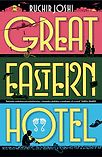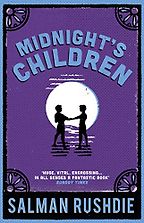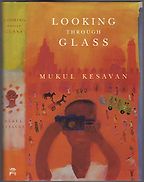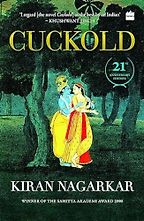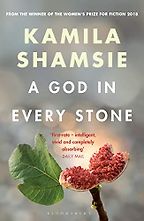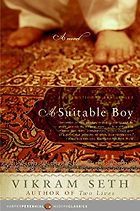Thank you for recommending this list of historical novels set in India. Would you say there are themes that unite them?
Kind of, yes, in the sense that the books I’ve chosen—except for Cuckold, which goes into medieval times—are all set in the 20th century, because that seems to be when English came to the forefront for a larger minority of Indians. Many more began speaking English, writing in English. And my own interest has been that very turbulent century, which produced an independent India. So that would be one bias, I suppose.
In India, you start seeing the novel form coalesce in the 19th century in Bengal and Gujarat, where you start getting these epic picaresque novels about Indian history, about warriors; the great woman warrior Rani of Jhansi, who fought against the British. These were popular, big novels printed in non-English Indian languages. But English is an Indian language now, and as we come into the 20th century, we get more focused on what you would recognise today as the historical novel.
Your own historical novel, Great Eastern Hotel, is set in 1940s Calcutta. What drew you to this place and period in particular?
My parents came from Gujarat, which is in the western part of the country, but my dad—who was a well-known writer in Gujarati—moved to Calcutta in 1939 as a young man. When I was growing up, he would tell me stories about the city, and say, ‘You wouldn’t recognise that city now.’
Also, I was always a Second World War nerd. When I was a kid, I very quickly got the European and white American history of the Second World War, but that leaves out anything that happened to people outside England, America, France, Germany, Russia. Maybe Japan, though we didn’t hear much from the Japanese point of view until a while later. The Indian experience, or the South Asian experience, where you have so many million soldiers fighting in the World Wars—you don’t get that until much later.
The Second World War period was a fascinating time where Calcutta, a very vibrant city, the second city of the British Empire, is suddenly dismantled, wrenched apart and put back together. For the longest time, the perception in the West, one which transfers itself to India as well, was that the city was the worst urban hellhole on the planet. How does that come about? And what part does that play in the formative mulch of Indian history before 1947?
And when you approach a book with this kind of ambition, how do you draw the line in terms of historical research? When do you allow yourself to jet off into fiction?
It’s a good question. Basically, I made the mistake of choosing the most turbulent and fecund period in terms of history and stories, so as I got deeper and deeper into the research and writing, I realised I was in a massive forest of stories and possibilities. The way out of that maze is to have characters. The characters react to historical events taking place, and also contribute to those events. So, my decision was to follow the characters. Even if there was some really delicious historical image or story I could have stuffed in, I tried to resist the temptation. It’s like being in a sweet shop; you can’t eat everything.
I’ve researched enough for two more novels. So much was going on! And even now, people keep coming to me and saying, ‘Do you know, in 1943, this happened in Calcutta?’ It’s endless.
The idea, at first, was to have a novel in three parts. Some sort of a trilogy. But as the story developed, it felt wrong to cut it. There was no natural ending, no place where I could break the manuscript into two or three books. Every section segued into the next to form this whole story. My editor looked at it and just said, ‘Look. This is working fine as it is. This is a single, big book. You just have to accept it. Own it.’ So that’s what it became.
Can we talk about your book recommendations? I want to start with Salman Rushdie’s Midnight’s Children.
It’s a good one to start with, because, for me, it was a great inspiration. I wasn’t planning to be a writer; I was planning to be a filmmaker. I still hope to make more films. I was house-sitting in New York after finishing college in Vermont, completely petrified of the Lower East Side. So, I got these books. One was One Hundred Years of Solitude by Gabriel Garcia Marquez and the other was Midnight’s Children.
I finished Gabriel Garcia Marquez first, then rapidly moved on. I thought to myself, how well Midnight’s Children sits next to Garcia Marquez. Yet it was different, as well. Both use a kind of magical realism. Both have the span of history. But in Midnight’s Children, here was somebody talking about my country in a voice that I recognized, not like the novels that had come before that about India—some of them very good, some of them harder work—which were all modelled on a kind of 19th-century realist novel, Russian or French or something. They all talked about India in a certain way. Whether it was an Indian writer or a foreign writer, there was a certain creation of Exotic India, a certain kind of decorum to the storytelling.
Rushdie blows all that apart, and at the same time, starts hitting historical points. It starts in Kashmir, then we see Jallianwala Bagh, then it moves through the turmoil of the 1930s, and then finally arrives at 1947 and Independence. What a fraught and troubled independence that was! We see a kind of split independence, through the point of view of two characters. Rushdie then brings it all the way to The Emergency, the Bangladesh War, and all the way through.
I thought it was fantastic. If he’d written a straight book, it wouldn’t have been so gripping. It’s gripping because of the magical realist elements, where he can freak out, take off, come back, play with language. All that was very, very inspiring. I wasn’t planning to be a writer, then. But I thought: if he can do this with a novel, I can probably do something as brave or as out of the box in a film, you know? That was the first book which triggered me to the idea of modern Indian historical fiction.
In the UK, this book found enormous acclaim. It won the Booker Prize in 1981 and has sold more than a million copies. Did it find the same favour in India itself?
The English readership in India in 1980 was much smaller, and the readership for serious fiction even smaller. Hundreds of thousands of more people read English now. When I got back from New York and talked about this book, people were like, ‘Yeah, I’ve heard of it. I’ve heard of the Booker Prize, yeah, interesting, I’ll read it.” There were definitely some people who had begun to read the book.
In 1983, Rushdie was on a promotional tour and I interviewed him. I actually had to go to the newspaper editor and say, ‘Salman Rushdie is coming! He’s won this prize!’ The editor said, ‘You want to interview this guy? Okay, do it.’
I was a young freelance reporter. You’d imagine people would be fighting over each other to interview Rushdie, but nothing. I ended up having a long conversation with him and the paper published a full-page interview, which was lovely.
“In India, you start seeing the novel form coalesce in the 19th century in Bengal and Gujarat”
Then it grew. By the time 1984, 1985 came around, a lot of people were annoyed with Indira Gandhi and her son Sanjay Gandhi. And Rushdie was seen as very critical of the Gandhis in his book. He makes fun of Indira and the Emergency. I think that found some traction. And he wrote Shame, about Pakistan, shortly after, which to me is not such a great book—he’s trying too hard, trying to force things—but it clicked into Midnight’s Children as a kind of twin set of historical books, and that again got more attention.
Let’s move to Vikram Seth’s A Suitable Boy. It centres on the arranged marriage of a young woman. But I’ve seen it compared to War and Peace for how it combines social manners with grand political narrative.
Vikram Seth is a great poet. His first novel, The Golden Gate, was a novel-in-verse, which is a huge, bravura achievement. Here, I think he deliberately took on the big 19th-century form I was talking about, but tries to do something quite different with it.
He takes his time going into these ox-bow lakes of narratives, moving away from the main thing and coming back. Ostensibly, yes, it’s about this young woman and who she will choose. Is it going to be Kabir, the cricketer? Is it going be Amit? Then this guy Haresh appears out of left field, not entirely of the same class but with qualities that the others don’t have.
There’s a little nod to Thomas Hardy’s Far from the Madding Crowd, those kinds of books. But alongside it is the whole history of India. It overlaps with Midnight’s Children because he starts in the 1930s, moves through independence and into the early years of the republic, the first elections. So, the marriage is coming together and coalescing across the history and geography of northern India. It starts in what is now Uttar Pradesh, moves to Calcutta and Delhi, comes back to Uttar Pradesh.
It’s a slow read, but once you get into it, it has all those pleasures of a really big novel. You lose track, come back to it, skip a few pages, go back, fill in the blanks as best you can. It’s a huge house through which you can happily wander. That’s a quality I like.
And Seth really loves his characters. He feels for them, perhaps more than Rushdie feels for his. It’s semi-autobiographical—it’s about his parents and family at one level, but it’s more than that too. And the writing is very elegant, very beautiful. There are descriptions of shoemaking, of Indian raga being sung as the monsoon breaks, of upper-class kids flirting at society parties in Calcutta.
The marriage plot is interesting, in my opinion, because it is such a profound question. When we choose a partner we are asking: What are my priorities in life? What kind of life do I want, if I can only choose one? Using that personal decision as a prism through which to view larger social or economic forces feels very natural.
Yes. And marriage in India has particular significance, right? It would be normal for a girl of Lata’s class to have an arranged marriage. She wouldn’t have that much of a say in it. But we are reaching a time where people, like my parents, had what was called a ‘love marriage.’ In Lata’s case, this is a decision she arrives at through convoluted means, while fighting against the pressures of a society which is asking her: ‘Why are you even thinking about who you are getting married to? Your parents will decide. Or they might give you a menu, and you’ll choose from what’s on it, i.e from a short-list of names.’
That’s the background score to the whole thing—women getting more powerful in modern India, and saying that the first thing they are going to decide is who they are going to marry. And parallel to that, they will study and gain qualifications, not be an adjunct to their husband’s career.
In fact, Vikram Seth’s mother was the first woman justice of the Supreme Court. My mother was headmistress of a girl’s school early in her life, a very powerful woman who educated herself, and that led to a life in which she was making all the decisions in partnership with my father.
But that was not common, and in fact even today is less common than it should be. But that’s changing.
Next you’ve selected Mukul Kesavan’s historical novel Looking Through Glass, which takes us back to 1940s India via a time slip. I liked what Publisher’s Weekly had to say about it, which was that it was “an unusual first novel that blends vivid realism, fantasy, raunchy sexual comedy, and political commentary.” That sounds great.
Mukul is a close friend now. I didn’t know him when I first read the novel, though, and I loved it. Again, it was a time where I wasn’t thinking of myself as any kind of writer. I was reading for pleasure and for curiosity. This book just drew me in.
Again, it has magical realism. Again, it’s about history. But it works very differently. Rushdie is interested in an epic span of many decades. His images are very startling. Images drawn in marker pen, you know? Broad colours, big outlines, startling stuff. Mukul is, to my mind, using magical realism more subtly, and with more complex colours. And because he is a historian, he knows that period very well.
In this book, a young photographer in 1980s Delhi is heading somewhere on a train. The train stops on a bridge over a river—or, as it often gets in the dry season, half-river and half-sandbank. As the man leans over to take a photograph, he falls off the bridge with his camera, falls through time, and when he lands on the river bank, he realises he has time travelled back to 1942. So, he’s in a strange position.
Five Books interviews are expensive to produce. If you're enjoying this interview, please support us by donating a small amount.
When he meets people, they find his dress and way of speaking a bit funny, but they don’t see him as an alien. They don’t realise he’s from the future, because he’s not carrying too many things – his suitcase has remained in the 1980s.
He realises that he can’t escape this time period, and he has to live there. People befriend him, thinking him to be homeless. They think he has memory loss and give him shelter. Except he doesn’t have memory loss. It’s just that he’s from the future and he can see the disasters and trauma these people are heading towards.
We meet a Muslim family in Lucknow. They are making decisions. Pakistan, at that time, is a kind of political gambit, even a joke. It’s not real, you know? It’s something the Muslim League is talking about to get more power and leverage. But suddenly it becomes more and more of a possibility. This family in north India has to make a decision about what they are going to do. There’s a grandmother who runs a great newspaper for women. There are people with love affairs and secrets. And all this is going on at a time of great Hindu-Muslim conflict.
Gandhi makes the decision with Nehru and Patel of the Congress to declare ‘Quit India’ in August, 1942.
This was the demand for an immediate end to British rule.
On one hand, it was a brave, quixotic decision. But what it does is completely bury the Muslim moderates within the Congress who were fighting to say that India should stay united, and that Muslims had a place alongside Hindus and all other religions. That they didn’t need a separate country.
They are cut off by this Quit India movement, and kind of disappear in the minds of the secular nationalists. In the book, magical realism continues throughout, a man is standing, a truck passes, and suddenly he’s just plastered as a two-dimensional image on the truck and he is gone. The Muslim disappears. It’s brilliantly done, it’s very funny, and it helps achieve what one is always trying to do as a historical novelist: to put yourself in the skin of characters who don’t know what’s coming. Sometimes their decisions lead to certain outcomes, other times their decisions are completely irrelevant because greater forces swat aside their agendas. Kesavan shows that beautifully. I was startled by the wisdom and sagacity of this book. It’s a real favourite.
We travel much further back in time for the fourth book you’ve selected—to the 16th-century kingdom of Mewar. Before we talk about Cuckold directly, we should briefly underline for international readers that, through much of the Middle Ages, India was made up of many smaller kingdoms and empires.
If you grow up with a Hindu background in north India, Meera Bai is a major religious figure. My parents, for example, would sing bhajans—popular devotional songs that have been written by different writers and composers across the centuries. They are not high scripture, they are not Sanskrit chants or shlokas. They show how popular worship of gods and goddesses can take place through song. Among these are many Meera Bhajans – songs written by Meera that still move people today.
Meera Bai is very famous, because she was a queen of Mewar and a very beautiful woman. Something flicks inside her and she becomes devoted to Krishna, as many people are, but for her the devotion becomes very real and tangible. Her songs to Krishna are full of love and imagery, which have resonated with people down the centuries.
This book is a kind of reimagining. You know that novel James, about the other guy in Huckleberry Finn? Or that novel from the perspective of Captain Ahab’s wife? Well, Kiran Nagarkar looks at Meera Bai and sees a woman who is no longer fulfilling any of her duties to her husband, who is the king. So the ‘cuckold’ of the title is the king, but he is cuckolded by God. It is the spiritual God who takes over his queen’s body, mind and soul every night, in every living moment. So, who is this guy, and what does he do?
It’s done beautifully. You don’t understand what is going on at first. Then you see this king at work. He’s actually a smart king. As you said, India is then made up of various smaller and bigger kingdoms. The invasions by Muslims from Central Asia, Turkey, Persia have begun. The spread of Islam across India has always been two steps forward, one step back. At this point, you have the Rajput kings of Rajasthan, who look at themselves as macho warriors—similar to the Vikings and the Mongols. Their ethos is all about fighting and dying. If you survive, great, but if not, you’re immortal, you become a legendary warrior king. But then there’s this guy, Meera’s husband, who is looking instead at sanitation and sewage and health.
In those days, the Hindu armies were not simply Hindu armies. They quite often had Muslim generals. It was nothing like the black-and-white thinking that the Hindu right in India likes to lay out now. A Hindu king would get his Muslim mercenary general and his Hindu soldiers to attack his neighbour, take over his kingdom. Then, as a stamp of authority, they’d burn down the neighbour’s temple. So, it wasn’t always Muslims burning things down—sometimes it was, but sometimes it was the Hindu kings themselves who desecrated temples. Hindus were also desecrating Buddhist sites, again to establish their hegemony over that territory, and over spirituality in that territory.
The Turks and the Persians relied on cavalry, muskets, cannon. The old style of Hindu fighting involved masses of soldiers and elephants, the king charging on an elephant and bulldozing the opposition. So, these were light, mobile armies versus sluggish large armies, and the small armies usually won.
The Rajputs had no concept of strategic retreat. You know, stuff like: draw the enemy in, pull back when you’re losing, live to fight another day. It was just charge and die. But the king in Cuckold starts to actually plan for retreats. If the day doesn’t go well, he says, we shouldn’t just commit suicide. We should pull back and see if we can defeat them the next day.
So, he’s doing all this, and at the same time, he is frustrated by his love and desire for this woman who he can’t attain, who is now in the women’s chambers in his castle. That push and pull is done very beautifully. It’s funny and moving, and at the same time dovetails into the Meera Bai songs, and the whole legend of Meera Bai quite brilliantly.
It’s very different. It’s not set in the 20th century. It’s not about Modernism. It’s about relationships between men and women, spirituality, the nature of rulers, and so on.
I don’t see much medieval historical fiction about India. But maybe I’ve not been looking.
No, it’s unusual. There is Sunil Gangopadhyay, who writes in Bengali but is translated into English. He writes about the 19th century. And now people are writing more and more about the times of the Mughals, or even before that. But when Kiran came out with this book—he was a friend who has sadly passed away—it was very unusual. He took a very Indian subject, a subject in which there are no western actors, no reference to things that Europeans or Americans or people from the Occident would recognise. I think it was very clever and inventive.
I think that might bring us to your final book recommendation, which is Kamila Shamsie’s A God in Every Stone. Again, a very ambitious novel with several strands. One is set in Peshawar. Perhaps you’d briefly address that point?
Peshawar was then part of India, or Greater India, which stretched from the borders of Iran at that point to—if you take in Burma—the borders of Siam and Cambodia, and to China at the top. Even if you leave out Burma, it’s basically from Assam all the way through what is now Bangladesh and Pakistan.
The story begins in Turkey, just before the First World War. A young Englishwoman is sent there to join an archaeological expedition led by a friend of her father’s, who is excavating the ruins of a site linked to an earlier explorer, the man who first mapped the Indus for Europe. At the dig, she finds herself working alongside an older Turkish archaeologist and slowly, unexpectedly, falling in love with him.
Then she’s called back home because the situation between Germany and England is very bad. She thinks she will be back in a few months, but, suddenly, Turkey joins hands with the enemy.
At the same time, millions of Indian soldiers are shipped to Europe to fight for the British Army as the First World War erupts. These soldiers find themselves in extremely alien situations in Flanders. They confront snow, and a flat, marshy landscape they are just not used to. They’re in the trenches, there’s incessant rain. And on top of that, the artillery bombardments and the gas attacks, machine gun fire, barbed wire, all the rest.
Two of these soldiers from Peshawar are badly injured. One loses an eye. They are moved to Brighton, where a massive hospital has been set up for Indian soldiers. But there they realise how little all this rhetoric of ‘we are one’ matters, how little the British officers or even the government cares for them. It’s a rude shock. They are maimed, crippled, almost killed, but those guys don’t give a damn. The Indians are regarded as third class citizens, almost sub-human. Then the soldiers come back to Peshawar.
Later, this young English woman is sent there too, to get her out of England. She wants to explore the area around Peshawar and the Indus. There, she meets these two former soldiers. Things develop from there.
The book has two main sections. First, the time around the First World War, then a decade later, when Gandhi’s movement is joined by a Pashtun from Peshawar called Abdul Ghaffar Khan or Badshah Khan. Many people call him ‘the Frontier Gandhi.’ But, as Kamila and others have said, he should be recognised a great freedom fighter in his own right.
Pashto culture is a very macho, martial culture. Badshah Khan tried to build a non-violent movement and did succeed, but felt betrayed after Partition when he suddenly found himself at the far-end of Pakistan, not a country he ever wanted to exist. He had been fighting for all of India to be independent, and for Muslims and Hindus to live together. In 1930, his activists and supporters were fired upon by both British and British-Indian soldiers during a massacre in Peshawar. One of the climactic scenes of the whole book takes place here.
So, the novel moves from ancient ruins, distant cultures, different ideas of conquest and hegemony, through the carnage of the First World War, and into the movements that would ultimately lead to Indian independence. Again, I love the way she’s done it. It’s not a fat book. She has condensed a lot into 350 pages. I loved reading it.
In terms of history, it helps you realise how history can compress, how things might be refracted in the remembering. All the things you want from a proper historical novel.
Absolutely, and to have a grasp of all these strands, all that was going on during a complex time must take a lot of work. Would you say the process of writing Great Eastern Hotel transformed your own understanding of Indian history also?
I would say so, yes. My book starts on the day the great poet Rabindranath Tagore dies. It was a major event in Calcutta. Hundreds of thousands gathered on the street to watch the funeral procession go by. The four young characters, the main characters of the book, are there, but they don’t know each other.
So, it’s also a portrait of a city during a time of great turmoil. As they make their way through the war years, these four people come across each other, have interactions. They meet and get to know each other in various ways. The war is continuing to squeeze Calcutta from the outset, but it touches the city only briefly, when the Japanese conduct bombing raids. The fear is of when the Japanese will bomb, when they will launch the seemingly inevitable ground invasion. By late 1942, the food has been sucked out of the villages and there is a massive famine across Bengal, which, remember, then includes what is now Bangladesh. These things create the dramatic moments in the book and change the characters’ lives.
The first period runs from 1941 to 1943, then there’s a second period in the 1970s where a character is looking back at the war years. I don’t go into Partition and the riots and famine directly, but I look at their after-effects—the toxic half-life of these traumatic events as they impact and effect people down the decades.
We are facing a time of great chaos, great uncertainty, and upending anxiety. It was useful for me, writing this book, to remember how that time must have felt during the war. There are ammunition factories, famine, political parties fighting for independence. And there is the whole idea of who we are—our culture, identity, the clash between Hindus and Muslims, men and women, communism and other political struggles.
Many of these things resonate with what is going on now, but that wasn’t necessarily intentional. I was just trying to write truthfully and vividly about that time. History was important, but the story, characters and their thinking even more so.
But yes, it does make me look at history, and where we are now, quite differently. I find myself thinking: yes, we are in a bad time, but it’s not the first bad time and it won’t be the last.
Interview by Cal Flyn, Deputy Editor
September 23, 2025
Five Books aims to keep its book recommendations and interviews up to date. If you are the interviewee and would like to update your choice of books (or even just what you say about them) please email us at [email protected]

